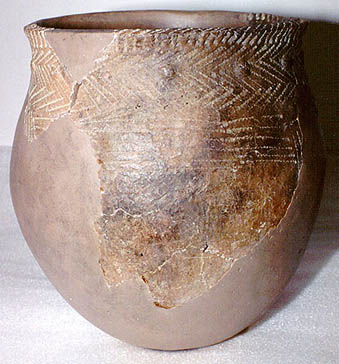
Exhibit Specimen 22
(CMCC BlDq-1:50)
David Keenlyside, Curator of Atlantic Archaeology, CMC:
 "Late in the summer of 1996, as I stepped out of my canoe onto the shore at Savage Island, I was about to come face to face with the past. There, lying in front of me, were scattered fragments of a ceramic pot, freshly eroded from the embankment. This had been a bad year for spring flooding and uprooted trees lay scattered along the banks of the St. John River just above Fredericton, New Brunswick. This was the traditional meeting place of the Maliseet annual council, on the other side of the river from their permanent village called Aukpaque, or 'head of tide'. The village was occupied until the late 18th century, just prior to people being moved to reserves at nearby Kingsclear and St. Mary's . Even until recent times, this was a popular gathering place for the Maliseet or Wolastoqiyik ("the people of the beautiful river"). It is said that 'when blossoms are on the trees, it is time to go to Aukpaque'. This was also the time of the spawning striped bass - a saltwater species which at one time commonly weighed over 25 pounds, often over 60 pounds. It must have been quite a sight to see spawning runs of such large fish.
"Late in the summer of 1996, as I stepped out of my canoe onto the shore at Savage Island, I was about to come face to face with the past. There, lying in front of me, were scattered fragments of a ceramic pot, freshly eroded from the embankment. This had been a bad year for spring flooding and uprooted trees lay scattered along the banks of the St. John River just above Fredericton, New Brunswick. This was the traditional meeting place of the Maliseet annual council, on the other side of the river from their permanent village called Aukpaque, or 'head of tide'. The village was occupied until the late 18th century, just prior to people being moved to reserves at nearby Kingsclear and St. Mary's . Even until recent times, this was a popular gathering place for the Maliseet or Wolastoqiyik ("the people of the beautiful river"). It is said that 'when blossoms are on the trees, it is time to go to Aukpaque'. This was also the time of the spawning striped bass - a saltwater species which at one time commonly weighed over 25 pounds, often over 60 pounds. It must have been quite a sight to see spawning runs of such large fish.
We knew from past archaeological surveys, going back to the turn of the century, that Savage Island had been occupied in pre-contact times. This was a large multi-component site which had been occupied seasonally for at least the past 3000 years. The river has changed over the centuries, systematically cutting new channels as it meandered between the numerous islands above Fredericton. With the construction of the Mactaquac dam in the late 1960's, a few kilometers upstream, the flow of the river has been interrupted causing higher flood levels and a flushing action which has accelerated erosion of the banks. During the past decade, more than three-quarters of the site has been lost to erosion. A mitigative archaeological project by the Kingsclear Reserve in 1994 resulted in brief testing of the site.
The restored vessel was one of three partially preserved vessels which we found that summer day. One of the other vessels was decorated with pseudo scallop shell stamp impressions and had preserved organic material adhering to the inner vessel wall. A small sample was removed for C-14 dating (AMS), producing a date of 2130+/- 60 years BP. In the Northeastern ceramic sequence, the pseudo scallop decoration is considered earlier than the dentate stamped decoration as found on the restored vessel. Another important characteristic of this vessel is what is referred to as 'exterior bossing', usually found as a single, horizontal row of circular raised bosses. The decoration is produced by pushing the end of a circular stick into the still wet clay from the vessel interior. Motifs of this period are typically horizontal bands of parallel,oblique or zigzag lines above the shoulder of the vessel."
Further Reading
Deal, M. and S. Blair
1991 Prehistoric Archaeology in the Maritime Provinces: Past and Present Research. The Council of Maritime Premiers, Maritime Committee on Archaeological Cooperation. Reports in Archaeology No.8.
Leavitt, R. M.
1995 Maliseet & Micmac: First Nations of the Maritimes. Tribune Printing, Sackville, New Brunswick.
Previous
Back to the beginning